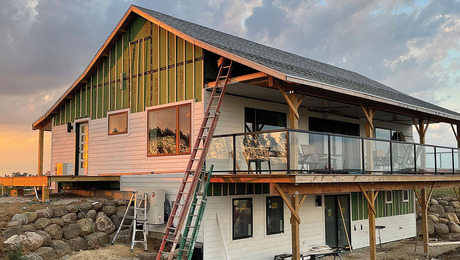| (Duplicate of posting in Knots) I’m a do-it-yourselfer who is designing some custom interior doors and trim for a Victorian remodel job. Two 5’x8′ openings with pairs of doors 30″ wide — see attachment. As shown, bottom rail = 10-1/2″, lock = 8″, top = 6″. Casings 5-1/4″, plinths 12″ tall, base+cap about 9″. 9′ ceilings. Regarding matching, old stuff is not really an issue. I’m keeping a few doors for upstairs rooms and I feel my new door design is a good match. But the “major” doors plus all trim will be new. I welcome your aesthetic comments. Can any of you suggest “classical” proportions? I’ve found it difficult to find appropriate examples for this relatively modest house; it does not have the extravagance of a Queen Anne or Italianate. But I want it to look good. I don’t want the stock lumber yard stuff — I find it painfully short & narrow. Nor do I want the highly ornate trim portrayed in most Victorian books (typically San Francisco gingerbread-on-steroids-ladies or East coast industrial-baron-behemoths). Also, I would appreciate recommendations for number of hinges (3 vs 4) and their heights (i.e. distance from floor to bottom of hinges)? These will have 1-3/4 oak frame with fair-size leaded-glass — so fairly heavy. Thanks! | 














Replies
Woody,
The design work I do is focused around 1900-1925, so a little bit later than the true Victorian period. However, it sounds like you want to stay on the simple side, so maybe the styles I'm used to will fit nicely.
Your proportions on the door look great. The only thing I'd consider changing would be to match the width of the top rail to that of the stiles (either make the stiles wider, or the top rail narrower). My eyes are used to seeing those two pieces be the same width.
Hinges? I would think quality over quantity. Three each side ought to be enough if they are of good quality. The old 1-3/4" solid doors I've worked on have three, and they've held up fine. As far as spacing goes, look at the old work, and use your eye. So far, you've shown a good aptitude: I'm sure the spacing you choose will look fine.
The height of the plinths looks great, as does the size of the baseboards. Looks like you're using a 1x8 base with a decorative cap; again, seems like a perfect way to go. As far as the shoe, I like using a 1/2x 3/4 or a 1/2x1 when using a taller base, like you have going.
Regarding the exterior drawing, the window casings as you've shown them look to be perfectly in tune with a simple Victorian house. Casings are usually 1x5 S4S all around, but depending on the height and scale of the windows, you might also consider 1x6s. (Depending on the thickness of the siding, you might have to bump up to 5/4 casings, but that's obvious.) I use 2x sills on the windows, and DON'T put aprons on the exterior - do it exactly the way you've drawn it. The caps are a great touch, too. Something on the order of a 1-3/4" bedmold or crown usually looks right, under a solid cedar 10-degree beveled drip cap. You might have to make the drip caps yourself to make sure you get enough projection to make them functional, but they're pretty easy to rip on a table saw.
Finally, I'd consider using some simple rake trim and some simple Greek returns and corresponding trim on the gable faces. I'll see if I can round up a picture to show you what I mean.
Ragnar
Ragnar - thanks for your detailed response and the encouragement. Regarding exterior trim, most of what you see in the drawing view is already up. Exterior casings are clear redwood 1x5-1/2" (actual) and the crown is a one-piece affair made of 2x6 redwood ripped in half, resorcinol-glued together, and then molded. They turned out nicely if I say so myself.
I didn't portray gable and rake trim in my AutoCAD models but the old stuff is there. I'll keep the nice ornamental shingles on the gable, but the rake trim is cheesy. I will replace it when I redo fascia and soffits (add venting) and put up my new gutter hangars (which will attach underneath the rafters - YES! Gutter hangars over shingles make me PUKE! It's bad enough we use shingles instead of standing seam or tile.)
I don't know what Greek returns are so I look forward to your picture...
Woody,
Window caps profile looks both nice and functional! Good job again!
I'll have to take a picture of my brother's house tomorrow and post it here - we put some simple returns on his house, and that's probably the quickest way to get a picture! ;)
You mentioned venting --- are you familiar with icynene foam? It's a spray-on, expanding insulation that DOES NOT require venting. It saves a tremendous amount of work on cathedral-ceiling applications, and it gets rid of that ugly bird block at the eaves.
Regards,
Ragnar
Woody,
I'm still looking for the Greek return details, but I came across a Victorian window treatment that you might find interesting. The head casing is oversized and supported with scrolled corbels. Notice also the blocks under the sill that visually act as an extension of the casings. It's probably more detailed than you're looking for, but parts of it could be incorporated if you wanted a little extra on the front of the house, for example.
Ragnar